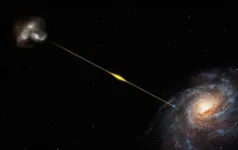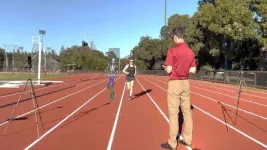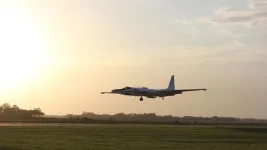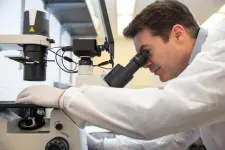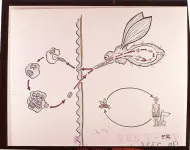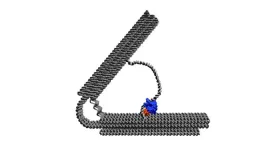(Press-News.org) An international team has spotted a remote blast of cosmic radio waves lasting less than a millisecond. This 'fast radio burst' (FRB) is the most distant ever detected. Its source was pinned down by the European Southern Observatory’s (ESO) Very Large Telescope (VLT) in a galaxy so far away that its light took eight billion years to reach us. The FRB is also one of the most energetic ever observed; in a tiny fraction of a second it released the equivalent of our Sun’s total emission over 30 years.
The discovery of the burst, named FRB 20220610A, was made in June last year by the ASKAP radio telescope in Australia [1] and it smashed the team’s previous distance record by 50 percent.
“Using ASKAP’s array of dishes, we were able to determine precisely where the burst came from,” says Stuart Ryder, an astronomer from Macquarie University in Australia and the co-lead author of the study published today in Science. “Then we used [ESO’s VLT] in Chile to search for the source galaxy, [2] finding it to be older and further away than any other FRB source found to date and likely within a small group of merging galaxies.”
The discovery confirms that FRBs can be used to measure the 'missing' matter between galaxies, providing a new way to 'weigh' the Universe.
Current methods of estimating the mass of the Universe are giving conflicting answers and challenging the standard model of cosmology. “If we count up the amount of normal matter in the Universe — the atoms that we are all made of — we find that more than half of what should be there today is missing,” says Ryan Shannon, a professor at the Swinburne University of Technology in Australia, who also co-led the study. “We think that the missing matter is hiding in the space between galaxies, but it may just be so hot and diffuse that it's impossible to see using normal techniques.”
“Fast radio bursts sense this ionised material. Even in space that is nearly perfectly empty they can ‘see’ all the electrons, and that allows us to measure how much stuff is between the galaxies,” Shannon says.
Finding distant FRBs is key to accurately measuring the Universe’s missing matter, as shown by the late Australian astronomer Jean-Pierre ('J-P') Macquart in 2020. “J-P showed that the further away a fast radio burst is, the more diffuse gas it reveals between the galaxies. This is now known as the Macquart relation. Some recent fast radio bursts appeared to break this relationship. Our measurements confirm the Macquart relation holds out to beyond half the known Universe,” says Ryder.
“While we still don’t know what causes these massive bursts of energy, the paper confirms that fast radio bursts are common events in the cosmos and that we will be able to use them to detect matter between galaxies, and better understand the structure of the Universe,” says Shannon.
The result represents the limit of what is achievable with telescopes today, although astronomers will soon have the tools to detect even older and more distant bursts, pin down their source galaxies and measure the Universe’s missing matter. The international Square Kilometre Array Observatory is currently building two radio telescopes in South Africa and Australia that will be capable of finding thousands of FRBs, including very distant ones that cannot be detected with current facilities. ESO’s Extremely Large Telescope, a 39-metre telescope under construction in the Chilean Atacama Desert, will be one of the few telescopes able to study the source galaxies of bursts even further away than FRB 20220610A.
Notes
[1] The ASKAP telescope is owned and operated by CSIRO, Australia’s national science agency, on Wajarri Yamaji Country in Western Australia.
[2] The team used data obtained with the FOcal Reducer and low dispersion Spectrograph 2 (FORS2), the X-shooter and the High Acuity Wide-field K-band Imager (HAWK-I) instruments on ESO’s VLT. Data from the Keck Observatory in Hawai'i, US, was also used in the study.
More information
This research was presented in a paper titled “A luminous fast radio burst that probes the Universe at redshift 1” to appear in Science.
The team is composed of S. D. Ryder (School of Mathematical and Physical Sciences, Macquarie University, Australia [SMPS]; Astrophysics and Space Technologies Research Centre, Macquarie University, Sydney, Australia [ASTRC]), K. W. Bannister (Australia Telescope National Facility, Commonwealth Science and Industrial Research Organisation, Space and Astronomy, Australia [CSIRO]), S. Bhandari (The Netherlands Institute for Radio Astronomy, The Netherlands; Joint Institute for Very Long Baseline Interferometry in Europe, The Netherlands), A. T. Deller (Centre for Astrophysics and Supercomputing, Swinburne University of Technology, Australia [CAS]), R. D. Ekers (CSIRO; International Centre for Radio Astronomy Research, Curtin Institute of Radio Astronomy, Curtin University, Australia [ICRAR]), M. Glowacki (ICRAR), A. C. Gordon (Center for Interdisciplinary Exploration and Research in Astrophysics, Northwestern University, USA [CIERA]), K. Gourdji (CAS), C. W. James (ICRAR), C. D. Kilpatrick (CIERA; Department of Physics and Astronomy, Northwestern University, USA), W. Lu (Department of Astronomy, University of California, Berkeley, USA; Theoretical Astrophysics Center, University of California, Berkeley, USA), L. Marnoch (SMPS; ASTRC; CSIRO; Australian Research Council Centre of Excellence for All-Sky Astrophysics in 3 Dimensions, Australia), V. A. Moss (CSIRO), J. X. Prochaska (Department of Astronomy and Astrophysics, University of California, Santa Cruz, USA [Santa Cruz]; Kavli Institute for the Physics and Mathematics of the Universe, Japan), H. Qiu (SKA Observatory, Jodrell Bank, UK), E. M. Sadler (Sydney Institute for Astronomy, School of Physics, University of Sydney, Australia; CSIRO), S. Simha (Santa Cruz), M. W. Sammons (ICRAR), D. R. Scott (ICRAR), N. Tejos (Instituto de Física, Pontificia Universidad Católica De Valparaíso, Chile) and R. M. Shannon (CAS).
The European Southern Observatory (ESO) enables scientists worldwide to discover the secrets of the Universe for the benefit of all. We design, build and operate world-class observatories on the ground — which astronomers use to tackle exciting questions and spread the fascination of astronomy — and promote international collaboration for astronomy. Established as an intergovernmental organisation in 1962, today ESO is supported by 16 Member States (Austria, Belgium, the Czech Republic, Denmark, France, Finland, Germany, Ireland, Italy, the Netherlands, Poland, Portugal, Spain, Sweden, Switzerland and the United Kingdom), along with the host state of Chile and with Australia as a Strategic Partner. ESO’s headquarters and its visitor centre and planetarium, the ESO Supernova, are located close to Munich in Germany, while the Chilean Atacama Desert, a marvellous place with unique conditions to observe the sky, hosts our telescopes. ESO operates three observing sites: La Silla, Paranal and Chajnantor. At Paranal, ESO operates the Very Large Telescope and its Very Large Telescope Interferometer, as well as survey telescopes such as VISTA. Also at Paranal ESO will host and operate the Cherenkov Telescope Array South, the world’s largest and most sensitive gamma-ray observatory. Together with international partners, ESO operates ALMA on Chajnantor, a facility that observes the skies in the millimetre and submillimetre range. At Cerro Armazones, near Paranal, we are building “the world’s biggest eye on the sky” — ESO’s Extremely Large Telescope. From our offices in Santiago, Chile we support our operations in the country and engage with Chilean partners and society.
Links
Research paper
Macquarie University press release
Photos of the VLT
Find out more about ESO's Extremely Large Telescope on our dedicated website and press kit
For journalists: subscribe to receive our releases under embargo in your language
For scientists: got a story? Pitch your research
Contacts
Stuart Ryder
Adjunct Fellow, School of Mathematical and Physical Sciences, Macquarie University
Sydney, Australia
Tel: +61 419 970834
Email: Stuart.Ryder@mq.edu.au
Ryan Shannon
Associate Professor, Swinburne University
Hawthorn, Australia
Tel: +61 3 9214 5205
Email: rshannon@swin.edu.au
Bárbara Ferreira
ESO Media Manager
Garching bei München, Germany
Tel: +49 89 3200 6670
Cell: +49 151 241 664 00
Email: press@eso.org
END
Astronomers detect most distant fast radio burst to date
2023-10-19
ELSE PRESS RELEASES FROM THIS DATE:
Imprinted genes in the ‘parenting hub’ of the brain determine if mice are good parents
2023-10-19
Whether a mouse is a good or bad parent can be traced back to imprinted genes in key neurons in the “parenting hub” in the brain, according to a new study by Anthony Isles of Cardiff University and colleagues, published October 19 in the journal PLOS Genetics.
In mice, there is some evidence that an unusual phenomenon in mammals called genomic imprinting impacts parenting behavior. Mammals inherit two copies of each gene – one from each parent – and usually, each copy is expressed equally in the cell. With imprinted genes, however, only one copy is expressed, ...
With smartphone videos, clinicians can analyze human movement using open source "OpenCap" platform, 25x faster and at a fraction of the cost of labs
2023-10-19
With smartphone videos, clinicians can analyze human movement using open source "OpenCap" platform, 25x faster and at a fraction of the cost of labs.
####
Article URL: https://journals.plos.org/ploscompbiol/article?id=10.1371/journal.pcbi.101XXXX
Article Title: OpenCap: Human movement dynamics from smartphone videos
Author Countries: US
Funding: SDU, AF, LK, JM, ASC, JLH, and SLD were supported by the National Institutes of Health (https://www.nih.gov; grant 1P41EB027060-01A1) and the Wu Tsai Human Performance Alliance (https://humanperformancealliance.org). ASC and MK were supported by Philips Healthcare (https://www.usa.philips.com/healthcare) ...
New smartphone app quickly analyzes human motion to aid physical rehabilitation
2023-10-19
WHAT:
A research team funded by the National Institutes of Health has developed a smart phone app that can track and analyze a person’s ability to move from one place to another, known as locomotion, and other types of movements. Human motion analysis is used to evaluate patients with movement difficulties, to help clinicians plan surgery, and to assess the results of treatment procedures. The research team believes that using the app costs about 1% of conventional motion analysis techniques and works 25 times faster. The study appears in PLOS Computational Biology.
Researchers tested their app, called OpenCap, with 100 participants. Using two or more smart phones, ...
BNP peptide a culprit in eczema
2023-10-19
Researchers from North Carolina State University have pinpointed a particular peptide’s role in activating atopic dermatitis, or eczema. The work could lead to more effective treatments for the condition.
Atopic dermatitis (AD) is a skin condition characterized by itching, irritated and thickened skin at the site of the irritation. The brain natriuretic peptide (BNP) is a peptide, or short chain of amino acids, that is elevated in patients with AD.
“BNP is expressed in sensory neurons, the neurons responsible for conveying sensation to the brain via the spinal cord,” ...
Researchers confirm postpartum depression heritability, home in on treatment mechanism
2023-10-19
CHAPEL HILL, NC – Postpartum depression (PPD), a common subtype of major depressive disorder, is more heritable than other psychiatric conditions, yet the genetics of PPD are understudied compared to these other psychiatric conditions., such as anxiety and bipolar disorder.
To remedy that, UNC School of Medicine researchers led an international team of researchers to conduct the largest-ever meta-analyses of genome-wide association studies (GWAS) to investigate the genetic architecture of PPD.
Published in the American Journal of Psychiatry, their research shows that approximately 14 percent of the variation seen in PPD cases can be attributed to common genetic factors. A patient’s ...
OU-led study documents new extremes in stratospheric water vapor
2023-10-19
A University of Oklahoma-led article published in Geophysical Research Letters highlights newly measured extremes recorded during the National Aeronautics and Space Administration Dynamics and Chemistry of the Summer Stratosphere field project.
“Extreme Altitudes of Stratospheric Hydration by Midlatitude Convection Observed During the DCOTSS Field Campaign,” led by OU School of Meteorology Interim Director and Associate Professor Cameron Homeyer, summarizes the extremes in measured stratospheric depth of hydration by convection recorded during the DCOTSS project as a whole, and ...
Can golden retrievers live longer?
2023-10-19
Golden retrievers are one of the most popular breeds of dogs. But research shows they have up to a 65% chance of dying from cancer. In a new study, University of California, Davis, researchers set out to find if certain genetic factors could help their survival rate. But instead of searching for genes associated with a cancer diagnosis in the breed, they instead chose to look for genes associated with longer life.
The gene they found is in a family of proteins long known to be important in human cancers. Specific versions or variants ...
University of Cincinnati researcher joins pediatric immunotherapy network
2023-10-19
Each year, approximately 200 to 300 children in the United States are diagnosed with diffuse midline gliomas (DMG), a tumor that begins in the brain or spinal cord.
The tumors cannot be removed through surgery due to their location in the brain, and current treatments are not effective and lead to a nearly zero percent survival rate.
The University of Cincinnati’s Timothy Phoenix is part of a multi-investigator collaborative team with St. Jude Children’s Research Hospital’s Stephen Mack, PhD, and Giedre Krenciute, PhD, that received a nearly $4 million National Cancer Institute (NCI) ...
New study provides ‘genetic fingerprint’ indicating disease spread by sand flies may be gaining firm foothold in the United States
2023-10-19
CHICAGO (October 19) — Scientists have new evidence that a tropical disease once seen almost exclusively in returning travelers is now being detected in the United States in people with no international travel history — and caused by a Leishmania parasite strain that’s distinctly different from “imported” cases, according to an analysis from researchers at the U.S. Centers for Disease Control and Prevention (CDC) presented today at the Annual Meeting of the American Society of Tropical Medicine and Hygiene (ASTMH).
The study, led by CDC scientist Marcos de Almeida, emerged from a curious rise of domestic infections over the last 10 years, ...
Researchers design a pulsing nanomotor
2023-10-19
An international team of scientists headed by the University of Bonn has developed a novel type of nanomotor. It is driven by a clever mechanism and can perform pulsing movements. The researchers are now planning to fit it with a coupling and install it as a drive in complex machines. Their findings have now appeared in the journal Nature Nanotechnology.
This novel type of motor is similar to a hand grip trainer that strengthens your grip when used regularly. However, the motor is around one million times smaller. Two handles are connected by a spring in a V-shaped structure.
In a hand grip trainer, ...
